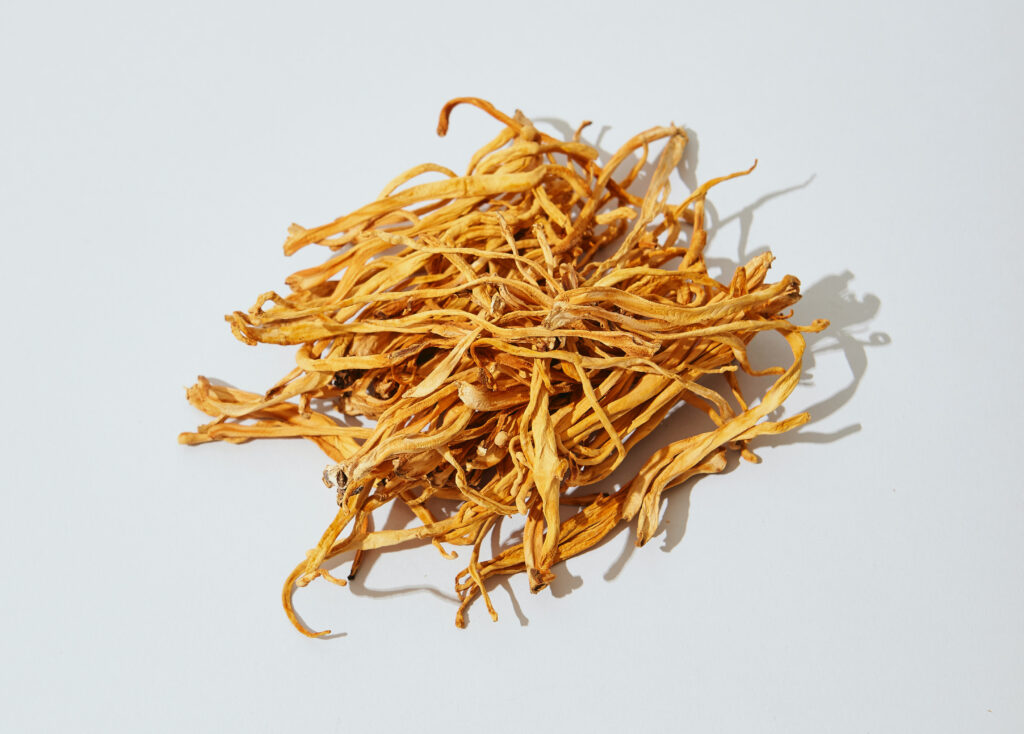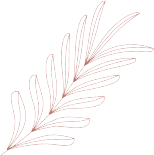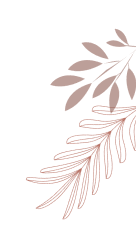
Cordyceps supplements have gained popularity in recent years amongst the Western world for its various health benefits ranging from improved athletic performance to its seemingly anti-tumor properties. Historically harvested from parasitic fungi infected caterpillars, cordyceps have been used in traditional Chinese medicine for over 700 years to nourish lung and kidney functions.1 Modern day research has found they may hold more perks than previously known sparking a new interest in this wonder fungus. Today’s supplements are most commonly derived from two fungi species: Cordyceps sinensis (also known as Ophiocordyceps sinensis) and Cordyceps militaris. In today’s article we will explore the biology behind the fungus and its purported medicinal and health boosting properties.
Biology
The term Cordyceps has been a bit of a buzz word amongst modern health podcasts, books, articles and has even found its way into mainstream television as the catalyst to the “zombie” apocalypse presented in HBO’s “The Last of Us” (based on the video game of the same title). So what exactly are Cordyceps? Simply put, they are a genus of over 400 parasitic fungi. While it is true that these fungi thrive on depleting resources within a host body, killing it in the process, they aren’t much of a threat to humans. Cordyceps are highly specific in host selection and have evolved to specialize in infecting arthropods (ie. invertebrates such as insects and arachnids) along with other fungi species.2 3
When shopping for Cordyceps supplements you will find that they are most commonly derived from either Cordyceps sinensis (C. sinensis) or Cordyceps militaris (C. militaris). In the case of C. sinensis, the spores commonly infect moth caterpillars and by-pass the host’s immune system responses. The spore then multiplies and forms a mycelium that begins accumulating its own biomass within the host’s body. The caterpillar eventually burrows itself into the earth during the cold winter months with the mycelium continually growing within. The host eventually succumbs to the overgrowth of mycelium at which point the fungus grows a fruiting body that protrudes from its host’s head and breaches the soil surface once warmer weather returns to start the cycle over again. Hence its Chinese name Dong Chong Xia Cao which translates to “Winter worm, Summer grass.” You will often find C. sinensis supplements sold in its entirety consisting of the dried caterpillar body containing the mycelium and the protruding fruiting body. C. sinensis is endemic to alpine habitats of 3000 m elevation within the Tibetan Plateau and efforts to lab grow this fungi have been difficult and time consuming with success achieved only when its natural conditions were simulated to a tee. As a result, this fungus is primarily collected by foraging, and due to its growing popularity has led the fungus to be over-harvested and is now considered an endangered species in China.3
C. militaris is very similar in nature to C. sinensis and is primarily found in East Asia, however it has been observed to be more widely distributed throughout the Northern hemisphere including Europe. While efforts on lab grown C. sinensis deemed laborious and expensive, C. militaris proved to be effective and economical. C. militaris, also capable of infecting an insect or fungi host, has been found to reliably grow on a variety of grain substrates such as brown rice, unlike its counterpart.1 4
C. sinensis vs. C. militaris
So which of the two is the superior species? Well depends on who you ask. Some traditional Chinese medicine purists may claim that the wild form of C. sinensis is more potent. Meanwhile, some research has suggested that C. militaris produces higher levels of bioactive compounds compared to sinensis. Both are great sources for cordycepin, ergothioneine, and other bioactive compounds.5 Out of the two, C. militaris does tend to offer the most bang for your buck given its cheaper costs related to lab production. C. sinensis requires more labor and export costs when harvested in the wild, and samples grown in the lab require time and more resources resulting in a heftier price tag.
C. militaris is also the more sustainable option as it is more dependably grown in controlled lab environments. Additionally, vegans and vegetarians may opt for C. militaris since it doesn’t require the presence of an insect host to produce.
Health Benefits
The health benefits of Cordyceps have long been recorded for centuries in China. Extensive modern day research has been carried out on the fungi and some reports have put forth convincing evidence to support historical claims of its medicinal and therapeutic properties.
Some of the positive health effects of Cordyceps that have been studied include its role in:
- Reducing fatigue 5
- Improving athletic performance6
- Improving memory and learning abilities7 8 9
- Anti-oxidative benefits6 5
- Supporting liver health10 6
- Assisting in kidney functions6
- Contributions to lung health6
- Reduces insulin resistance6
- Potentially inhibiting cancer/tumor cell growth11 12 6
Active Ingredients
Cordyceps contain various bioactive compounds that contribute to its many health benefits. The following compounds and nutrients have been found to be present in Cordyceps:6
- Cordycepin – This compound has been extensively researched for its role in a range of biological activities. Studies show it has the potential to boost the immune system, reduce inflammation, reduce cholesterol levels in blood, helps regulate hormone production, and boost sperm cell production. Cordycepin is similar in structure to adenosine which plays an important role in energy transfer within the cells. While adenosine helps protein synthesis within the cell, cordycepin has the ability to do the opposite by impeding cellular function thus blocking its ability to create proteins. This interesting feature has been the focus for some scientist conducting research on how to manage cancer cells. Additionally, cordycepin is able to trick adenosine receptors in the brain to make one feel relaxed and reduce the feeling of fatigue.
- Polysaccharides – Cordyceps contain a diverse array of these complex carbohydrates that are comprised of chains from simpler sugars such as mannose, glucose, galactose, arabinose, rhamnose, and xylose. Polysaccharides help reduce inflammation and act as antioxidants. They have also been found to help reduce cholesterol & blood sugar levels, support the immune system, and promote liver health.
- Amino acids – Non-protein amino acids such as Gamma-Aminobutryic Acid (GABA) and Ergothioneine have been found in Cordyceps. GABA helps us manage our emotions and reduces anxiety/stress by improving our quality of sleep. It is also beneficial as a muscle relaxant and has even been found to help improve our memory/learning abilities. Additionally, Ergothioneine is known for its anti-inflammatory and anti-oxidative properties.
- Carotenoids – Carotenoids including β-carotene, lycopene, lutein and zeaxanthin have all been found in Cordyceps and contribute to the fruiting bodies orange/yellow hue. Studies have shown that lutein and zeaxanthin can help improve cognitive functions and relieves stress by reducing cortisol levels. Additionally, studies have found that there is a correlation between β-carotene and lycopene rich diets and positive immune system functions.
- Lovastatin – Lovastatin is a valuable compound that aids in cholesterol management
- Phenolic acids & flavonoids – These compounds found in Cordyceps provide protection from oxidative damage.
- Vitamins & minerals – Cordyceps contain a medley of vitamins and minerals including vitamin A, B2, B3, C, E, magnesium, potassium, and selenium which aid in various body functions ranging from fighting fatigue to supporting our immune system.
Supplements Available
Today you can find Cordyceps in a variety of forms but are most commonly found as a pill, extract powder, tincture, and as a dried fruiting body (or in the case with C. sinensis, as a dried fruiting body plus caterpillar). Some may find the pill or tincture form quicker to incorporate into their routine. Others may enjoy the extract powder for its flexibility in incorporating into food and beverages. The intact dried form also offers opportunity to incorporate into dishes or have it brewed as a tea.
When purchasing C. militaris pills, extract powders, and tinctures be sure to research the product to verify its derived from the fruiting body versus the mycelium. Think of the mycelium as the “root system” of the fungi. It’s the fungi web that infiltrates the nook and crannies of the growing substrate. Removing the mycelium from the growing substrate would prove to be a difficult task, especially at the scale that manufacturers face. Instead the entire growing substrate and the mycelium it contains are ground up and processed together. Thus, mycelium derived supplements may be diluted with the excess grain material that make up the growing substrate, whether it be brown rice, wheat, etc.13
Side Effects
Some studies have found that Cordyceps consumption may cause headaches, dry mouth, nausea, abdominal distention, and diarrhea. Additionally, some research noted that some Cordyceps samples used in their studies had traces of lead and other heavy metals which can have detrimental effects on the body.6 14 15 These heavy metals are typically derived from its surrounding environment, primarily its growing medium. When purchasing supplements it is important to make sure you’re buying from a reputable manufacturer who conducts 3rd party testing for purity and quality of the cordyceps.
Are Cordyceps right for you?
Cordyceps have a list of potential benefits ranging from boosting immune health, respiratory health, increases energy and stamina and overall helps your body adapt to stressors. More research should be done on cordyceps but the research that is out there shows cordyceps in an impressive light. The key to trying cordyceps would be to first speak with your doctor. It’s always a good idea to have a conversation with your primary care physician before beginning any new supplements.
Starting slow with implementing cordyceps into your diet is the best way to reduce side effects and monitor how your body responds to it.
Supplements can often interact with medication so again, speak with your primary physician before adding cordyceps to your routine especially when on medication.
Depending on how the supplement works for you you may want to adjust the time you take it. For example, if you get the boost of energy with cordyceps in a short period of time, you may want to take it before your work out or when going to work for high performance. Observe your results and adjust accordingly.
Like everything in life, moderation is key. While there is no general dosage for consumption, a good start would be to follow the amount directed on the supplements label.
As you begin your exploration of cordyceps it’s important to realize that individual responses may vary. Taking a thoughtful and informed approach will enable you to potentially unlock the incredible benefits of this mysterious fungus that can contribute to positive changes in your overall well-being.
Also read: Magnesium: The Remedy to Menstrual Cramps
References
- Olatunji, O. J., Tang, J., Tola, A., Auberon, F., Oluwaniyi, O., & Ouyang, Z. (2018). The genus Cordyceps: An extensive review of its traditional uses, phytochemistry and pharmacology. Fitoterapia, 129, 293–317. https://www.sciencedirect.com/science/article/abs/pii/S0367326X18305550?via%3Dihub ↩︎
- Fitzgerald, A. (2023, November 28). Could Cordyceps fungi infect humans?. Medical News Today. https://www.medicalnewstoday.com/articles/cordyceps-in-humans ↩︎
- Paterson R. R. (2008). Cordyceps: a traditional Chinese medicine and another fungal therapeutic biofactory?. Phytochemistry, 69(7), 1469–1495. https://doi.org/10.1016/j.phytochem.2008.01.027 ↩︎
- Liang, Z. C., Liang, C. H., & Wu, C. Y. (2014). Various grain substrates for the production of fruiting bodies and bioactive compounds of the medicinal caterpillar mushroom, Cordyceps militaris (Ascomycetes). International journal of medicinal mushrooms, 16(6), 569–578. https://doi.org/10.1615/intjmedmushrooms.v16.i6.60 ↩︎
- Jędrejko, K. J., Lazur, J., & Muszyńska, B. (2021). Cordyceps militaris: An Overview of Its Chemical Constituents in Relation to Biological Activity. Foods (Basel, Switzerland), 10(11), 2634. https://doi.org/10.3390/foods10112634 ↩︎
- Lin, B. & Li, S. (2011). Chapter 5 – Cordyceps as an Herbal Drug. In Herbal Medicine biomolecular and clinical aspects. essay, CRC Press. Retrieved December 17, 2023, from https://www.ncbi.nlm.nih.gov/books/NBK92758/. ↩︎
- Kim, Y. O., Kim, H. J., Abu-Taweel, G. M., Oh, J., & Sung, G. H. (2019). Neuroprotective and therapeutic effect of Cordyceps militaris on ischemia-induced neuronal death and cognitive impairments. Saudi journal of biological sciences, 26(7), 1352–1357. https://doi.org/10.1016/j.sjbs.2018.08.011 ↩︎
- Yuan, G., An, L., Sun, Y., Xu, G., & Du, P. (2018). Improvement of Learning and Memory Induced by Cordyceps Polypeptide Treatment and the Underlying Mechanism. Evidence-based complementary and alternative medicine : eCAM, 2018, 9419264. https://doi.org/10.1155/2018/9419264 ↩︎
- Shweta, Abdullah, S., Komal, & Kumar, A. (2023). A brief review on the medicinal uses of Cordyceps militaris. Pharmacological Research – Modern Chinese Medicine, 7, 100228. https://doi.org/10.1016/j.prmcm.2023.100228 ↩︎
- Liu, X., Zhong, F., Tang, X. L., Lian, F. L., Zhou, Q., Guo, S. M., Liu, J. F., Sun, P., Hao, X., Lu, Y., Wang, W. M., Chen, N., & Zhang, N. X. (2014). Cordyceps sinensis protects against liver and heart injuries in a rat model of chronic kidney disease: a metabolomic analysis. Acta pharmacologica Sinica, 35(5), 697–706. https://doi.org/10.1038/aps.2013.186 ↩︎
- Park, C., Hong, S. H., Lee, J. Y., Kim, G. Y., Choi, B. T., Lee, Y. T., Park, D. I., Park, Y. M., Jeong, Y. K., & Choi, Y. H. (2005). Growth inhibition of U937 leukemia cells by aqueous extract of Cordyceps militaris through induction of apoptosis. Oncology reports, 13(6), 1211–1216. ↩︎
- Zhang, W., Yang, J., Chen, J., Hou, Y., & Han, X. (2005). Immunomodulatory and antitumour effects of an exopolysaccharide fraction from cultivated Cordyceps sinensis (Chinese caterpillar fungus) on tumour-bearing mice. Biotechnology and applied biochemistry, 42(Pt 1), 9–15. https://doi.org/10.1042/BA20040183 ↩︎
- Plumb, T., Carver, J., Kersula, M., McInnis, M., & Berecka, M. (2020, October 14). Mushroom extracts: The mycelium vs. fruiting body dispute. North Spore. https://northspore.com/blogs/the-black-trumpet/mushroom-extracts-the-mycelium-vs-fruiting-body-dispute ↩︎
- Ashraf, S. A., Elkhalifa, A. E. O., Siddiqui, A. J., Patel, M., Awadelkareem, A. M., Snoussi, M., Ashraf, M. S., Adnan, M., & Hadi, S. (2020, June 12). Cordycepin for Health and wellbeing: A potent bioactive metabolite of an entomopathogenic medicinal fungus cordyceps with its nutraceutical and therapeutic potential. MDPI. https://www.mdpi.com/1420-3049/25/12/2735 ↩︎
- Cleveland Clinic. (2022, July 7). Heavy metal poisoning (heavy metal toxicity): Symptoms, causes & treatment. https://my.clevelandclinic.org/health/diseases/23424-heavy-metal-poisoning-toxicity
↩︎





You must be logged in to post a comment.